This month - |
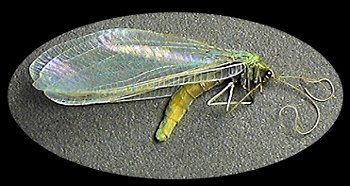 |
This month - |
 |
Like most amateur microscopists and naturalists no doubt, I always keep an eye open for something interesting to study under the microscope, either the stereo or compound. The other day while on a walk I found a dead green lacewing in good condition, so popped it in the empty 35mm film cassette I usually carry for the odd things I find and brought it back for a closer look.
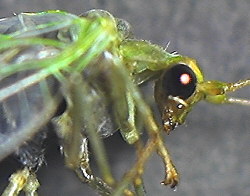 |
Lacewings are one of my favourite insects, they have large intricately veined wings and the green lacewing shown above and left has beautiful copper coloured eyes when they catch the light. |
The image at the article head doesn't really capture the majesty of the insect, as the body and antenna have dried and curled up. (I shouldn't have left the insect overnight before photographing). In life the antenna are long, straight and delicate.
One of the first things I noticed when starting to study the insect was a rather bad smell. I later learnt that lacewings release noxious smelling fluids when threatened (and is sometimes called the stinkfly), so this fluid albeit in the dead insect was the probable cause.
| The image right shows one pair of front and hind wings and highlights the wonderful veining and just a hint of their delicate translucency. The top wing is 22mm long. | 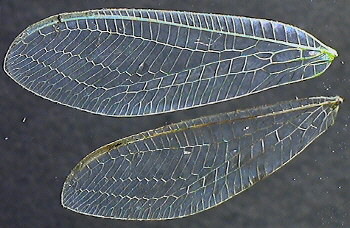 |
| The image right shows part of one antenna of the lacewing viewed under a 3.5X objective and incident lighting. Note the two different types of hairs. The antenna is ca. 0.2mm wide. | 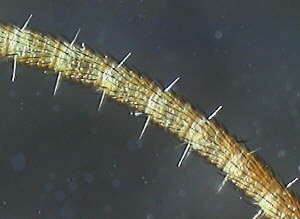 |
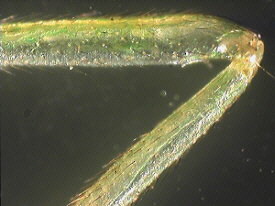 |
The image left shows part of one of the lacewing legs. The delicate green of the lacewing is also seen in the legs. Image taken using a 3.5X objective and incident lighting. |
I sub-titled this article 'green lacewings, the delicate destroyers', as their appearance belies some of their habits. Here's a few intriguing aspects about them.
This chance find provided an enjoyable few hours of study under the microscope.
So when you're out on a walk or in the garden, especially at this time of year (mid-summer at the time of writing), when many insects are breeding and then dying, keep an eye out for interesting specimens .... even the humblest insect can provide a fascinating few hours of study and background reading.
Comments to Dave Walker welcomed.
References and further reading
1. 'Natural History of the Garden' by M. Chinery, Collins (Fontana) 1977. A wonderful book if you haven't come across it, well written and beautifully illustrated and covers most fauna and flora commonly found in a garden - from brambles to 'bugs' and birds!
2. 'Collins Guide to the Insects of Britain and Western Europe' by M. Chinery, 1986. Arguably one of the best single guides to a selection of the insects most commonly found in the area covered.
3. Encyclopaedia Britannica, 15th edition 1993. Most large encyclopaedias should have a good section on the insect Order Neuroptera and possibly lacewings.
Tip on photographing wings
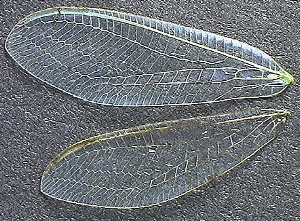 While preparing this article I was
disappointed with the images I captured of the wings using my
usual cheap and cheerful technique of laying the insect parts on
black card and photographing with strong sidelighting. The
texture of the card although very subtle was as prominent as the
wings and distracting i.e. see the image right.
While preparing this article I was
disappointed with the images I captured of the wings using my
usual cheap and cheerful technique of laying the insect parts on
black card and photographing with strong sidelighting. The
texture of the card although very subtle was as prominent as the
wings and distracting i.e. see the image right.
So for the image earlier in the article, I put the wings on the lid of a glass petri dish and put the black card underneath. This put the card out of focus, but a benefit I hadn't anticipated, is that the strong low sidelighting was now to some extent coming from below and providing a sort of darkfield effect which emphasised the translucency of the wings.
First published in August 1998 Micscape Magazine.
Please
report any Web problems or offer general comments to the Micscape Editor,
via the contact on current Micscape Index.
Micscape is
the on-line monthly magazine of the Microscopy UK web
site at Microscopy-UK